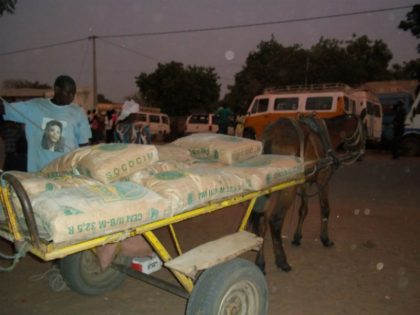 This project has been completed under the direction of Peace Corps Volunteer Leah Spare. To read about the beginning of the project, CLICK HERE.
This project has been completed under the direction of Peace Corps Volunteer Leah Spare. To read about the beginning of the project, CLICK HERE.
The project was to construct three public pit latrines for Yallal Ba.
Leah reports:
The Yallal Ba Public Latrine Project is finished!
We wanted to buy all of the materials at once and store them in the village storage shed to reduce the amount of time it would take to have a horse cart bring back each material as needed. My counterpart, Juma, and I purchased materials in the town of Farafenni at the cement shop, metal rods shop, hardware shop, and corrugated metal shop.
We transported the materials to our village 4 k away in two hired horse cart. The bulk of the materials and expense consisted of 46 bags of cement, which took two trips.
Juma and I went to the buy the nails and metal rods. The nails were to keep the corrugate sealed to the wood, and the wood connected to the cement. The metal rods functioned as support for the cement inside of the latrine. By the time the cement, nails, and metal rods were purchased and taken to Yallal Ba, the sun had set. Since my area of the Gambia is without electricity, the purchase of corrugate and timber was to be done the next day.
Juma and I bought the timber and brought it to Yallal Ba in branches of a meter to two meters in length.
The corrugate was then put as a needed donation. Juma called and asked villagers. The villagers would now not only need to put in the manual labor for the project but the corrugate as well.
Thankfully, within two days, enough corrugate was salvaged and was put in the materials pile in the storage shed. Having seen the materials already bought and waiting for them, the villagers immediately started digging the latrines.
There are three “streets” of Yallal Ba and each “street” would be given a latrine. Because of this, the citizens that lived on each street claimed ownership of their latrine by coming and working together and digging the hole that would soon share a section of their street. The men in Dagaa worked on the Dagaa latrine. The men and boys in Legaal shoveled and scooped in Legaal. The young men in Cinchu were in charge of digging the latrine in Cinchu.
While some villagers were digging, others were diligently creating cement blocks with a single metal brick mold. The women would bring in gallons of water on their heads and pour them into the mounds of cement and soil while the men mixed and then molded each brick.
By week two, the holes were dug. The first rains of the season arrived within that time and helped the ground soften for the workers. They lined the holes with cement blocks and made molds of the cement floor which included the latrine hole.
They kept building up, outside of the hole chamber, to make a walled structure. The latrine hole was plugged until the roof and doors were attached because all Gambians are terrified of snakes and an empty latrine was the ideal living quarters for a snake. Since nearly every man had built his own house using cement or, more commonly, mud bricks, the masonry work went quickly.
By the fourth week, the corrugate, timber, and nails were added to the equation and the roof and doors were attached.
Another Village Development Committee meeting was held to give updates on the latrine project and to advocate proper cleaning and maintenance of the latrines.
All in all, the project was a complete success. The villagers are thrilled they have six new latrines (there are two in each latrine) and I am proud of how dedicated the villagers worked.
Thank you, Water Charity. You made this possible.













